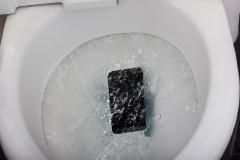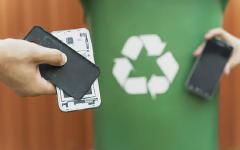Categories
Worth their weight in gold? Why the minerals in your phone matter
6 minute read

Did you know the brilliant technology in your mobile phone is powered by some precious, and extremely finite, materials?
It’s weird to think about. The fact is, we’re all walking around with a pocket full of precious materials.
Gold, silver, diamond and platinum feature in many models of smartphone. That should give you one clue as to why mobile phones cost so much nowadays.
But these materials are even more significant than their value as precious metals and gemstones. Because, like fossil fuels, the minerals in your mobile phone are finite resources. Once we’ve used them all up, they’ll be gone forever.
So, what can we do to preserve some of these materials for the future?
What minerals are found in my phone?
The exact list of materials will differ according to each phone. However, National Museums Scotland has listed some 42 minerals, including several precious metals, that can be found inside many consumer phones.

Here’s a breakdown of materials most commonly used in smartphones:
Batteries:
Cadmium
Widely used in mobile phone batteries.
Diamond
Used to make electrodes in mobile phone batteries.
Iron
Every mobile phone is about 3% iron. It’s used in everything from the casing, frame and battery, to accessories like the charger.
Lithium
The key component in your lithium-ion battery, lithium is a lightweight material that is excellent at storing electricity.
Nickel
Used to build electrical connectors, capacitors and as part of the phone battery.
Casing:
Aluminium
Used in cases, circuit boards and a variety of other components.
Bromine
Another essential component in the casing of your mobile phone.
Chromium
Used to make mobile phone cases.
Cobalt
The beautiful blue gemstone is an essential component in lithium-ion batteries.
Fluorine
Often found in mobile phone cases, some brands are also experimenting with fluorine’s potential as a battery.
Magnesium
Widely used in phone casings due to its ability to absorb vibrations and shield against electromagnetic interference.
Oil shale
Found primarily in the casing.
Titanium
At twice the strength and half the weight of steel, titanium is becoming increasingly common in mobile phone cases.
Circuit boards:
Antimony
A great semiconductor, antimony can be found everywhere from the batteries to the circuit board.
Barium
This final ingredient in your mobile phone is yet another that is essential in the circuit board.
Gold
Used in wires and as a conductor in circuit boards.
Lead
Found in a variety of components, including the circuit boards, battery and in PVC components.
Manganese
A key component in both circuit boards and mobile phone batteries.
Quartz
A multifunctional gemstone that can power the internal clock, work as a battery and act as a circuit board conductor.
Silver
Used as a conductor in circuit boards.
Strontium
Another essential material in circuit boards.
Sulphur
Already widely used in circuit boards, researchers are now considering sulphur’s potential as a battery material.
Tin
Used as a solder in circuit boards.
Zirconium
Also known as a ‘fools diamond’, this mineral is used to make mobile phone circuit boards.
Displays and touchscreens:
Mercury
Found in the battery, circuit boards and especially in your phone’s crystal display.
Monazite
Containing a host of Real Earth Elements (REE), monazite is used for a variety of purposes, mainly in producing lighting.
Potassium
Used in the production of touchscreen glass.
Salt
A key ingredient in touchscreens and casings, and many British dishes.
Yttrium
This material produces phosphors that help produce the lighting in your display screen.
Zirsilite
The cerium in zirsilite is a key material in the glass used to create your touchscreen.
Electrodes:
Platinum
Used to coat electrodes to make them more stable.
Hardware and accessories:
Lanthanum
Handy at extending your phone’s battery life, it’s also found in the circuitry, and in the vibration motors.
Tungsten
It’s thanks to tungsten that your phone is able to vibrate. You’ll also find it in your speakers.
Zinc
Zinc alloys are used to make mobile phone chargers.
Microchips:
Arsenic
Poisonous to humans, but essential to camera chips.
Boron
Used to make microprocessor and camera chips.
Phosphorus
Used to make microchips and microprocessors.
Wires and circuitry:
Beryllium
Used to make connectors and wires.
Bismuth
The colourful, geometric ingots of bismuth are not only beautiful, but great for producing wires and connectors.
Copper
Used to make wires and connectors.
Tantalum
Tantalum is found in wires and connectors, where it regulates voltage, and in the speakers, where it helps improve audio quality.
Wulfenite
A beautiful orange stone, that happens to be an excellent material in building wires and connectors.
Wowsers. That’s a long list of materials right there. But the story doesn’t end here. All of these minerals need to come from somewhere.
Usually, that ‘somewhere’ is a huge mineral mine somewhere in the world. Wherever there’s a rich pocket of minerals, there’s sure to be a mineral mine sooner or later.
The problem with mineral mining
According to the UK’s Centre for Sustainable Mineral Development, mineral mining causes all sorts of problems.
As well as destroying natural landscapes and animal habitats, it leaves behind mineral waste and pollution. Cracking open rocks also releases sulphide ores, which creates sulphuric acid.
This is why legislation around mineral mining in the UK is quite tough. Waste reduction is encouraged, national parks and environmentally significant areas are protected from mining and, when quarrying and mining has finished, sites are re-developed for future conservation or community use.
But this is not true of other countries. In some places, especially developing countries, mineral mining is a bit of a free-for-all. This is contributing to environmental problems.
The cause of the problem is multi-dimensional. Low accountability, the location of mines close to human habitats and a lack of law enforcement are just some of the reasons mining is contributing to environmental damage in places like Niger, the Democratic Republic of Congo, Cameroon and Zambia.
How do we put an end to it?
There’s no easy answer to this question.
In a bid to stem the demand and encourage alternatives, many countries are taking steps to reduce their reliance on mined minerals. But the simple fact is that minerals are essential to the gadgets we love and this will probably be the case for a while.
There is one positive thing we can do to reduce the impact of mineral mining, however, and that is to recycle our old gadgets and buy pre-used gadgets, or new gadgets made with recycled materials.
That’s why, at giffgaff, we encourage you to trade in your old phone when you no longer need it. And replace it with a refurbished handset, instead of buying brand new.
Not only could this save you loads of money, it helps to ensure that the minerals and precious metals in your phone won’t go to waste. Plus, you won’t be adding to the over-mining of minerals in order to produce new mobile phones.
Recycling mobile phone handsets is a small change that, if more people do it, could make a big difference in the long run.





